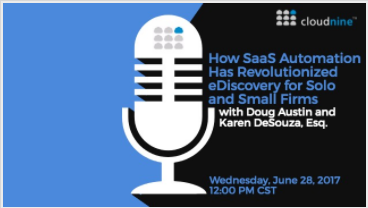This New Pilot Program Can Speed Up Discovery, Especially in Arizona and Illinois: eDiscovery Best Practices
At its meeting in September of 2016, the Judicial Conference of the United States approved a pilot program to test procedures requiring mandatory initial discovery before the commencement of party-directed discovery in civil cases. Now, that pilot program – the Mandatory Initial Discovery Pilot Program – is already in use in Arizona and Illinois.
The Mandatory Initial Discovery (MIDPP) Pilot Program has been designed to test whether early substantial disclosure of information can reduce litigation costs and shorten the time for case resolution consistent with the goals of Rule 1 of the Federal Rules of Civil Procedure, which requires the court and the parties to employ the rules “to secure the just, speedy, and inexpensive determination” of every case.
As noted in the Above the Law article (Holy Early Discovery, Batman! You’ll Want To Know About This, written by Kelly Twigger), the District of Arizona (effective May 1) and the Northern District of Illinois (effective June 1) “have adopted the MID pilot project for three years. The pilot requires parties to produce all discovery in support of their case (consistent with Rule 26(a)) but ALSO all discovery that is relevant to the opposing parties’ claims and/or defenses. And wait, it gets better — responses have to be filed within 30 days of filing an answer (which everyone now has to do) and documents must be produced 40 days later.”
And, as the description “mandatory” implies, the MIDPP will apply to all civil cases in the volunteer courts, subject to certain specific exemptions. According to Twigger, those exemptions are “pro se cases, PLSRA matters, MDL matters, and patent cases.”
The Federal Judicial Center site provides several resources regarding the MID Pilot program here, including:
- Introduction to the Mandatory Initial Discovery Pilot: A twenty-two-minute video description (transcript here) of the pilot project’s goals and procedures by Judge Paul Grimm, from the District of Maryland, who chairs the Pilot Projects Working Group of the Civil Rules Advisory Committee (and was also the presiding judge in the very first case we ever covered in this blog).
- Mandatory Initial Discovery Pilot: A Discussion of Practice and Effects: A sixty-eight-minute panel discussion by judges and attorneys in Arizona’s state courts who have experience with the type of mandatory initial discovery disclosures required by the pilot project.
There is also a Checklist page and a Users’ Manual page that provides a general checklist and user’s manual for the MIDPP, as well as specific checklists and user’s manuals for the District of Arizona and the Northern District of Illinois.
So, what do you think? Will the Mandatory Initial Discovery Pilot Program lead to a speedier and more proportional discovery cycle? As always, please share any comments you might have or if you’d like to know more about a particular topic.
Give yourself a pat on the back if you recognize the movie where the graphic came from – Copyright © Paramount Pictures. Don’t recognize it? Surely, you can’t be serious!

Disclaimer: The views represented herein are exclusively the views of the author, and do not necessarily represent the views held by CloudNine. eDiscovery Daily is made available by CloudNine solely for educational purposes to provide general information about general eDiscovery principles and not to provide specific legal advice applicable to any particular circumstance. eDiscovery Daily should not be used as a substitute for competent legal advice from a lawyer you have retained and who has agreed to represent you.







